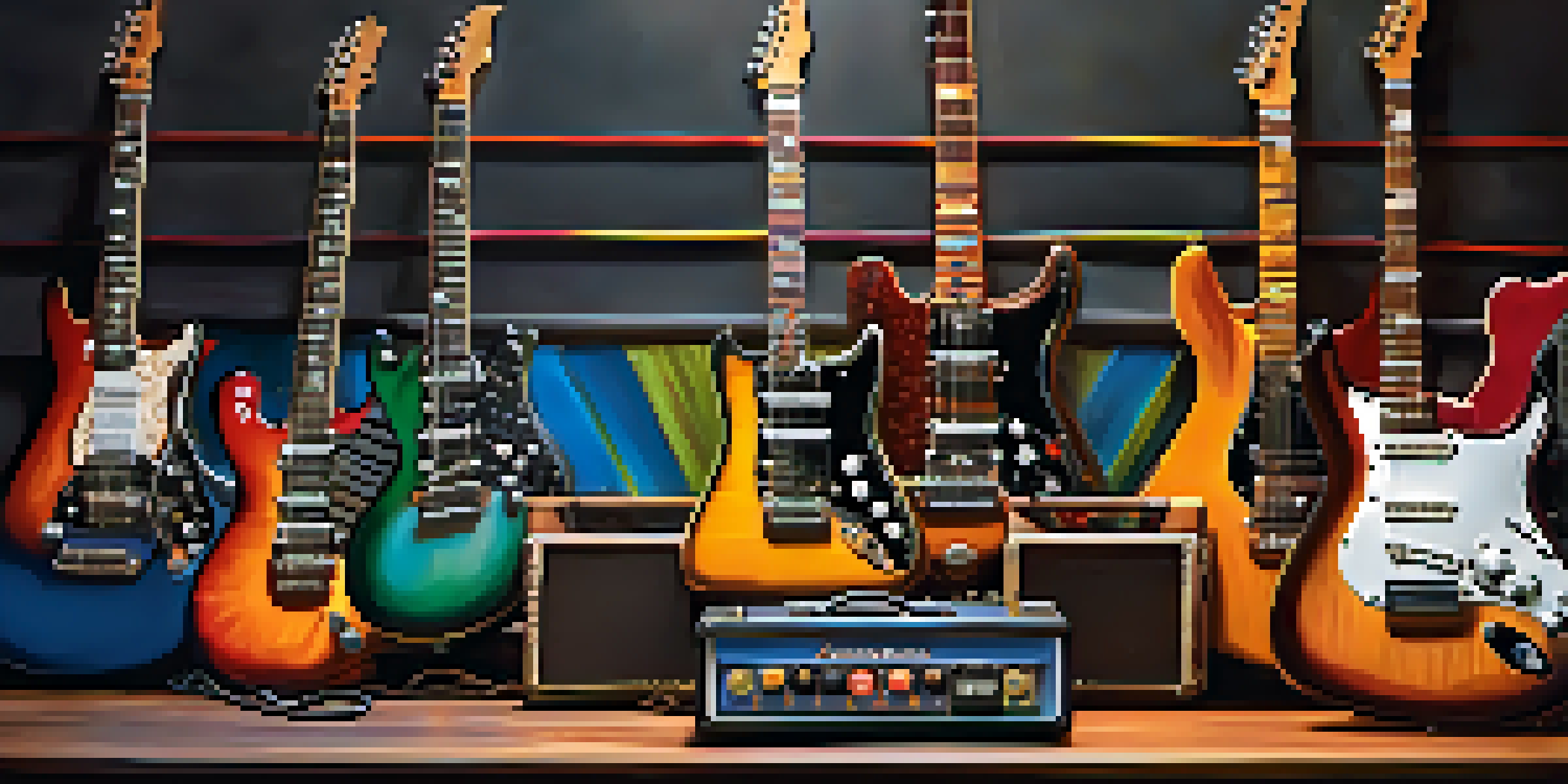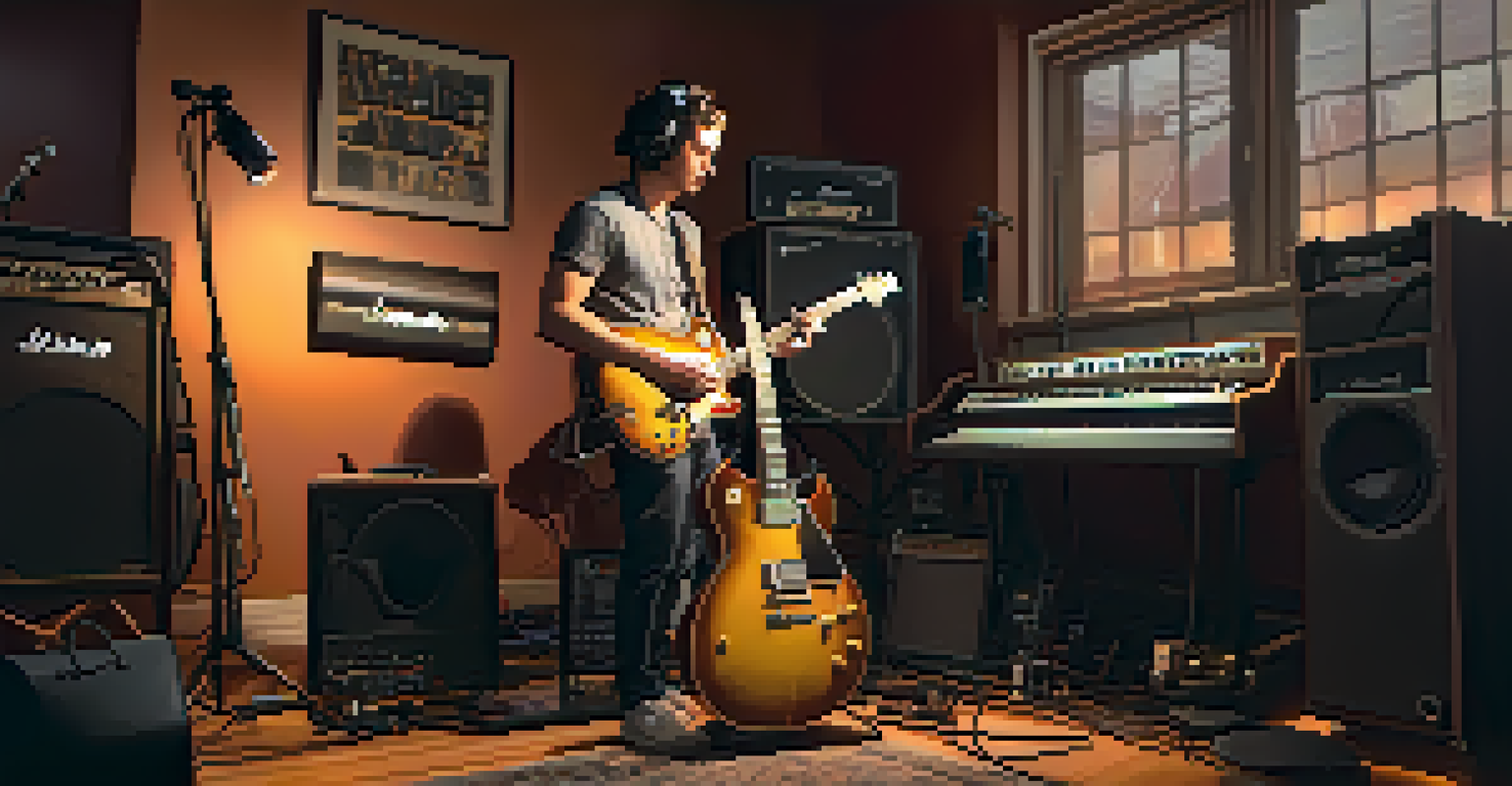Experimenting with Effects: Crafting Your Guitar Identity

Understanding Guitar Effects: Your Sound Palette
Guitar effects are like colors on a painter's palette, allowing you to create a unique sound. They range from simple distortion to complex delays, and each effect can drastically change your tone. By experimenting with different effects, you can find combinations that resonate with your musical style. Think of it as mixing flavors in cooking; sometimes, the most unexpected combinations create the best dishes.
The beautiful thing about learning is that no one can take it away from you.
To get started, familiarize yourself with the basic types of effects: modulation, delay, reverb, and distortion. Each serves a distinct purpose and can be used in various ways. For instance, a chorus effect can thicken your sound, while reverb can add depth and space. Understanding these fundamentals helps you make informed choices as you dive deeper into crafting your guitar identity.
Don't hesitate to explore beyond your comfort zone. Experimenting with effects can lead to discoveries that transform your playing. Just as an artist needs to experiment with different styles and techniques, you should feel free to try out unusual combinations and settings. This exploration is essential for developing a sound that truly represents you.
The Importance of a Signal Chain: Building Your Setup
Your signal chain is the order in which your effects are placed, and it significantly impacts your tone. A typical setup might start with distortion, followed by modulation effects like chorus, and end with delay and reverb. Each arrangement will produce different results, so it's worth experimenting with the order to find what works best for you.

For example, placing a reverb before a distortion pedal can create a lush, ambient sound, while the opposite order might yield a tighter, more focused tone. Think of your signal chain as a recipe; the order of ingredients can change the final dish entirely. By playing with the arrangement, you can discover new sonic landscapes and refine your unique sound.
Experiment with Guitar Effects
Exploring different guitar effects can help you discover a unique sound that resonates with your musical style.
It's also essential to consider the type of guitar and amp you’re using. Different guitars and amplifiers will interact differently with your effects, adding another layer of complexity. Remember, the journey to finding your perfect sound is not a race but an exploration, so take your time and enjoy the process.
Exploring Analog vs. Digital Effects: What’s Right for You?
When it comes to guitar effects, you'll often hear the debate between analog and digital. Analog effects usually provide a warm, organic sound, while digital effects offer versatility and a wide range of options. Each has its pros and cons, so the choice largely depends on your personal preferences and playing style.
Music is the shorthand of emotion.
Analog pedals can produce unique character and warmth, making them a favorite among many guitarists. However, they can be less flexible than their digital counterparts. Digital effects, on the other hand, can emulate multiple sounds in one unit and often come with presets, making them convenient for live performances or recording sessions.
Ultimately, the best approach is to try both and see what resonates with you. Combining analog and digital effects in your setup can also yield exciting results. Think of it like blending different musical genres; the fusion can lead to a sound that’s entirely your own.
Finding Your Unique Sound: The Role of Experimentation
Finding your unique sound involves a lot of trial and error. It’s not just about choosing effects; it’s about how you use them. Don’t be afraid to tweak settings, play with different styles, and even break the ‘rules’ of traditional sound design. Some of the most iconic guitar sounds came from unconventional methods and creative experimentation.
For instance, you might discover that using an overdrive pedal with a clean amp produces a subtle warmth you love. Or, you might find that layering multiple effects creates a rich tapestry of sound that defines your style. Keep a journal of your settings and combinations so you can remember what worked and what didn’t.
Master Your Signal Chain
The order of your effects in the signal chain dramatically influences your tone and overall sound.
Remember, every guitarist has a unique journey, and your sound will evolve as you grow. Embracing experimentation not only enhances your creativity but also helps you connect more deeply with your music. Let the process be as enjoyable as the end result.
Incorporating Effects into Your Playing Style
Once you've explored various effects and settled on your favorites, it's time to integrate them into your playing style. This means understanding how different effects can enhance your musical expression. For example, a subtle delay can add depth to your solos, while a heavy distortion can drive home a powerful riff.
Consider the dynamics of your playing; using effects thoughtfully can help you build tension and release in your music. Experiment with pedal engagement during different song sections to see how it affects the overall feel. This dynamic use of effects can captivate your audience and elevate your performance.
As you incorporate effects, stay true to your musical voice. It's easy to get carried away with gadgets, but remember that the goal is to enhance your sound, not overshadow it. Keep your core musical identity at the forefront, using effects to complement and express it more fully.
Recording Techniques: Capturing Your Sound
When it comes to recording your guitar sound, capturing the nuances of your effects is crucial. Ensuring that your signal chain remains intact during recording allows you to maintain the integrity of your sound. This means paying attention to mic placement, amp settings, and, of course, the effects used.
Consider using a combination of close miking and room miking to capture both the detailed sound of your guitar and the ambiance created by your effects. This approach can add depth and richness to your recordings, making them more engaging. Experiment with different types of microphones and placements to see how they affect your sound.
Develop Your Signature Tone
Trusting your instincts and embracing experimentation is key to developing a signature tone that reflects your identity as a guitarist.
Don’t forget to record in different settings as well. Sometimes, the same setup can yield varying results in different environments. Whether in a studio or your living room, the acoustics can play a significant role in how your effects are heard. This exploration will help you hone in on the best way to capture your unique sound.
Developing Your Signature Tone: Trusting Your Instincts
Developing a signature tone is an ongoing journey that requires patience and self-awareness. Trusting your instincts when selecting effects and settings is vital. Often, your gut feeling about what sounds good will guide you toward your unique identity as a guitarist.
Listening to your favorite guitarists can provide inspiration, but remember that their sound is a reflection of their journey. Use their tones as a springboard to explore your own ideas rather than a blueprint to follow. This mindset fosters creativity and encourages you to find what truly resonates with you.

As you solidify your tone, don’t be afraid to evolve. Your sound may change as you grow as a musician, and that’s perfectly okay. Embrace the process, and let your guitar identity continue to develop as you explore new effects and techniques.